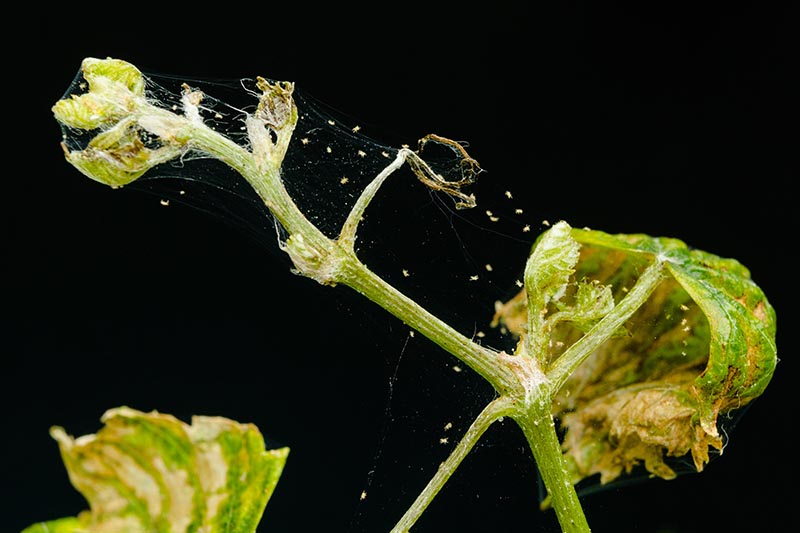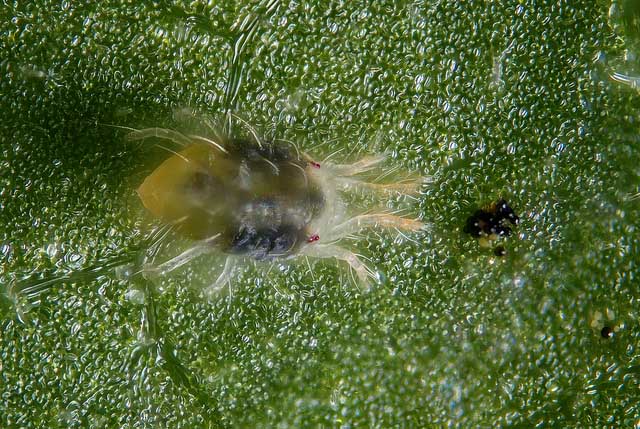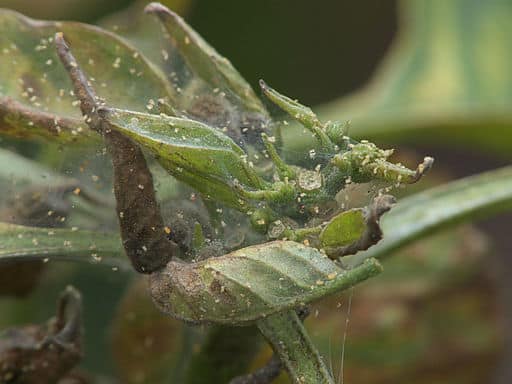One of the most disappointing things as a gardener is to spend all spring ... Read More
- Home >
- All about Spider Mites and How to Get Rid of Them
All about Spider Mites and How to Get Rid of Them

Home growers and gardeners tend to be quick to learn one of the most uncomfortable truths about pests: tiny bugs are likely to be the biggest nuisance and to cause the quickest destruction – and spider mites, in particular, seem set on proving this!
These annoying little arachnids can quickly take over any garden or potted plant, especially if your ecosystem has been messed around with chemical insecticides. They are surprisingly resilient and quick to reproduce, to the point that rabbits could learn a thing or two from them!
The key when dealing with spider mites is to act quickly and decisively. But since the wrong kind of strong approach can cause almost as much damage to plants as the pest itself, my philosophy is always the same: know your enemy first. If you need to learn how to get rid of spider mites, then the following guide is for you.
Quick Facts on Spider Mites
| Origin | Originally from Eurasia, but now they can be found across all tropical and temperate regions |
| Common Names | Spider mite, Red spider, Red spider mite, Two-spotted spider mite, Broad mite |
| Scientific Names | The most common ones are Tetranychus urticae and Panoychus ulmi, but there are hundreds of species, subspecies, and regional variants. |
| Identification | Extremely small arachnids, which often appear as tiny reddish or greenish spots to the naked eye. Adults grow only up to 0.4 mm long. |
| Favorite Plant Hosts | Roses, Potatoes, Tomatoes, Peppers, Eggplants, most beans, Chickpeas, Cherries, Apples, Stone fruits (peaches and plums), Clovers, Various Grasses, Hemp, most annual flowers |
| Remedies | Neem oil, Miticide blends (Bug Blaster, NukeEm, horticultural oil), Foggers, Predatory bugs (ladybugs, minute pirate bugs, big-eyed bugs) |
Where do Spider Mites Come From?
A long time ago, spider mites were only a problem in Eurasia – although it’s hard to say which side of it. At this point, they’re found across the world. If you live somewhere with a cold winter, at least you will only have to worry about potential infestations during half the year.
What does a Spider Mite Infestation Look Like?
Spider mites themselves are too small to be seen by the naked eye unlike other larger pests like squash bugs, June bugs. In all their six-legged glory – at most, you will be able to recognize greenish or red spots if you look at a plant closely. Their favorite place to hide is under the leaves.
Different species of spider mites have different colors, and some of them even have stripes, but you’d need a microscope to see that much detail.
The initial stages of a spider mite infestation can be recognized as small, dark brown or “burnt” spots on the surface of the leaves. A good way of identifying the pest at this stage is to wipe these little burnt spots with a soft tissue. If it’s mites, you should be able to see little streaks of mite blood.
Afterward, the eggs appear. These are small, spherical, and transparent.
To protect their eggs, spider mites produce a dense, very fine, sticky web that can quickly cover the entire plant. This will prevent your plant from getting enough sunlight and from transpiring or breathing properly. You don’t want to wait until the infection reaches this stage though.
Types of Spider Mites
As I mentioned before, there are literally hundreds of different species of spider mites. I will now focus on the four big subtypes that are most common across North America and Europe.
Red mites
Personally, I have always found that these tend to look pinkish rather than a proper red. This subspecies is particularly prolific, and a colony can completely cover an indoor plant in a couple of days. As they’re so small, they are usually only visible after an entire leaf (or several) has been completely covered by a haze of tiny dark pink spots.
Broad mites
Despite their name, these are actually smaller than red mites: where a red mite can grow to up to 0.4 mm, broad mites usually stay within the 0.1-0.2 mm range. However, broad mites can be extra virulent and deadly to your plant.
This is because female mites they secrete a toxic growth hormone into the plant that will literally poison it. This is in addition to all the nutrients they are already robbing your orchids and roses from.
Their tell-tale sign is that any infected leaves will start curving upwards near the edges as if they were wilting. After this happens, it usually takes less than five days for that leaf to turn dark-bronze and to dry off completely.
Hemp russet mites
The best thing to say about hemp russet mites is that they leave no webbing. That is the only quality they have, unfortunately – in every other sense, they’re awful.
Hemp russet mites are the smallest of the common mites, so they can really only be seen with a microscope. They also have only two legs, rather than the six that broad or red mites sport. As they are relatively slow climbers, they will usually crawl their way up into the plant – leaving a trail of brown, burnt damage behind.
Cyclamen mites
These are broad mite’s 8-legged, fast-breeding cousins. As a bonus nuisance, they have tiny claws that they use to climb over stems and leaves. Out of all common mites, they are also the ones that are fondest of humidity. This makes them particularly dangerous for greenhouses.
Although they will colonize almost any plant they meet, they tend to prefer low-lying flowering plants with delicate or soft leaves, as they are the easiest to perforate with their claws. African violets tend to be a favorite.
From Birth to Destruction: The Life Cycle of Spider Mites
Thanks to their wide variety of subspecies and types, the life cycle of spider mites will also be very varied. Their total life span will range from five days to a full month, and the speed in which they spawn also varies. However, it never varies to be too fast for comfort (University of Florida).
Spider mites come in both female and male versions. Female mite eggs require fertilization, while males do not. After a female lays her eggs, these will take between one to three days to hatch.
The tiny larvae will then go through two separate stages (protonymphal stage and deutonymphal stage) before becoming a sexually-mature adult. Once they reach this stage, females will immediately begin seeking an available male to fertilize their eggs – although they always make sure they leave some unfertilized, to ensure there are future males to come. Provided temperatures stay above 80°F, females will get themselves fertilized and hatch more eggs continuously – and then proceed to cover its nests with the dreaded webbing that signs a late-stage infestation. Although they only live around a month in average, each female can produce hundreds of eggs during her life.
If temperatures drop below 70° F, fertilized females will enter a state of diapause or dormancy, and wait until the weather turns warm again.
Damage and Symptoms of Spider Mites
There are two main ways in which spider mites will harm your plants: by feeding and by the webbing they use to protect their eggs (American Orchid Society).
Feeding Damage
Spider mites suck dry the nutrients and chlorophyll directly from your plant’s leaves. As they are so small, they usually do this cell by cell. This is why the initial signs of their feeding are usually just tiny brown or dry spots underneath the leaf.
As hard to notice as they are at first, once they begin reproducing and you get a small army on your windowsill, they can affect an entire leaf within a day. Leaves will then change color and turn dark yellow or brown; the edges will start curling up, and eventually dry off.
Webbing Damage
As I mentioned in the Life Cycle section, most species of spider mites are infamous for the spider-like web they use to hide and protect their eggs. Females will usually start creating this web immediately after laying their eggs. This web will then prevent water and light from reaching the plant, hindering photosynthesis – which is essential for the plant’s survival.
Depending on the type of plants you are growing, the damage can be simply aesthetically unpleasant, or it may kill off the plant entirely. Roses and African violets, which are notoriously frail, are particularly susceptible to this.
When it comes to food crops, they can cause your tomatoes or peppers to receive sunburn damage, or to become stunted – as the whole plant will be suffering if photosynthesis becomes impossible. If you are growing beans, peas, or anything that comes in a pod, you may be looking at losing the entire harvest: spider mites will feed off the pods themselves.
Spider Mite Control
Just like with any other pest, I usually advocate a prevention-first approach. Once they have invaded your field, there are chemical, biological, and physical methods you can use to banish them.
Prevention
Your first line of defense should be quarantined. Always make sure that any new cutting or gifted plant you bring to your home or greenhouse is completely clean. Because they’re so tiny and hard to spot, this is particularly important when it comes to preventing spider mites: even if just two or three manage to get inside your greenhouse unnoticed, they can become 500 hundred in five days, and 500 x 500 in ten days.
For the plants that are already in your home, try any of the following:
Control their environment: spider mites like hot and dry spaces. Keep your plants well hydrated, shade the leaves from direct sunlight, and spray them with some water to ensure they don’t get the chance to become too comfy.
Dust them off frequently: This will double as a chance to both prevent and detect a potential pest before it gets out of hand. Pay special attention to the hidden surfaces underneath each leaf. Remove and examine any dust on them at least once a week.
Rinse and wipe any suspicious leaves: gently, grab a moist cloth and wipe off each leaf from your rose bushes. This should be done every couple of weeks, throughout the summer.
Get bug allies: Get a few ladybugs to help you protect your ornamental plants. They’re pretty on their own, they are harmless and silent – and they will keep their living space free of myriads of other pests (Cedar Circle Farm).
Fighting Spider Mites – Pest Control Tactics
Getting rid of spider mites once they have appeared is no easy task. For those of you who are trying to strike the right balance between “decisive” and “safe for my family greenhouse,” try the following:
Isolate: After detecting an infected plant, immediately remove it somewhere far away from its peers. This is easier for indoor potted plants, naturally, but it still ought to be attempted in the garden
Mite-killing products: Make sure you read all labels properly to ensure they are safe, effective, and actually work against mites. Keep in mind that spider mites are arachnids, not insects so that insecticides will be laughed off as a perfume by most spider mite colonies.
Bug bombs: If the sick plant is in a pot and you can easily move it to its own room, where it won’t be within reach of other plants, pets, or people, try using a sulfur-based spray or “bug bomb.”
Neem oil: Personally, this is one of my favorite horticultural oils, as it works against a large variety of pests. It is quite effective against spider mites, but you should ensure any plants treated with neem oil are kept away from children or pets.
Clean off the plant and environs: Wash each leaf carefully with a gentle soap and wipe it clean. Also, replace any mulch or hummus that may be surrounding the plant – spider mites love to hide in there!
Get them eaten off: Biological controls are a great, family friendly way to both prevent and exterminate spider mites without accidentally harming the family dog. Some of the most popular species used against spider mites can be bought in greenhouses or specialized stores, and they include:
Ladybugs: Pretty and fond of both mites and aphids – a single ladybug will eat up to 5000 a day.
Lacewings: Not to be confused with lacebugs, which are actually a pest of its own. They will eat most larvae and caterpillars, in addition to mites.
Minute pirate bugs: A great live-and-let-live friend for your outdoor plants, they can become a bit of an annoyance indoors (The Canadian Organic Grower).
Spider mite destroyers: Also known as Stethorus punctillum, these little tanks are akin to bringing the heavy, specialized artillery. They will target spider mites specifically, and can eat hundreds of both adults and larvae per day (Cornell University).
Predatory thrips: This tiny black and white insects will feed off your garden’s pest – although unfortunately they are often mistaken for plant-sucking species (University of Minnesota).
Big-eyed bugs: Despite being very similar to chinch bugs, true big-eyed bugs are actually harmless and very helpful to get rid of spider mite larvae.
Conclusion
Spider mites are known to be the bane of many home horticulturists and gardeners. Tiny and quick, they can wreak havoc across an entire rose garden in a matter of days. Look out for their signature brown spots before the webbing begins its own damage – and don’t hesitate to experiment with the many beneficial bugs that can make a meal out of them.
Related Content
-
A Guide to Winter Plant Protection
-
The Best Grow Tents of 2023
If you don’t have a permanent structure for your garden or you want total ... Read More
-
Despite environmental concerns, 3 in 5 Gen Zers buying roses for partners this Valentine’s Day
According to a 2021 global study, 59% of young adults ages 16-25 are very ... Read More
-
Calcium Nitrate Fertilizer – How to Use It on Your Plants
Even gardeners with the greenest thumbs need a little help sometimes. Calc... Read More







